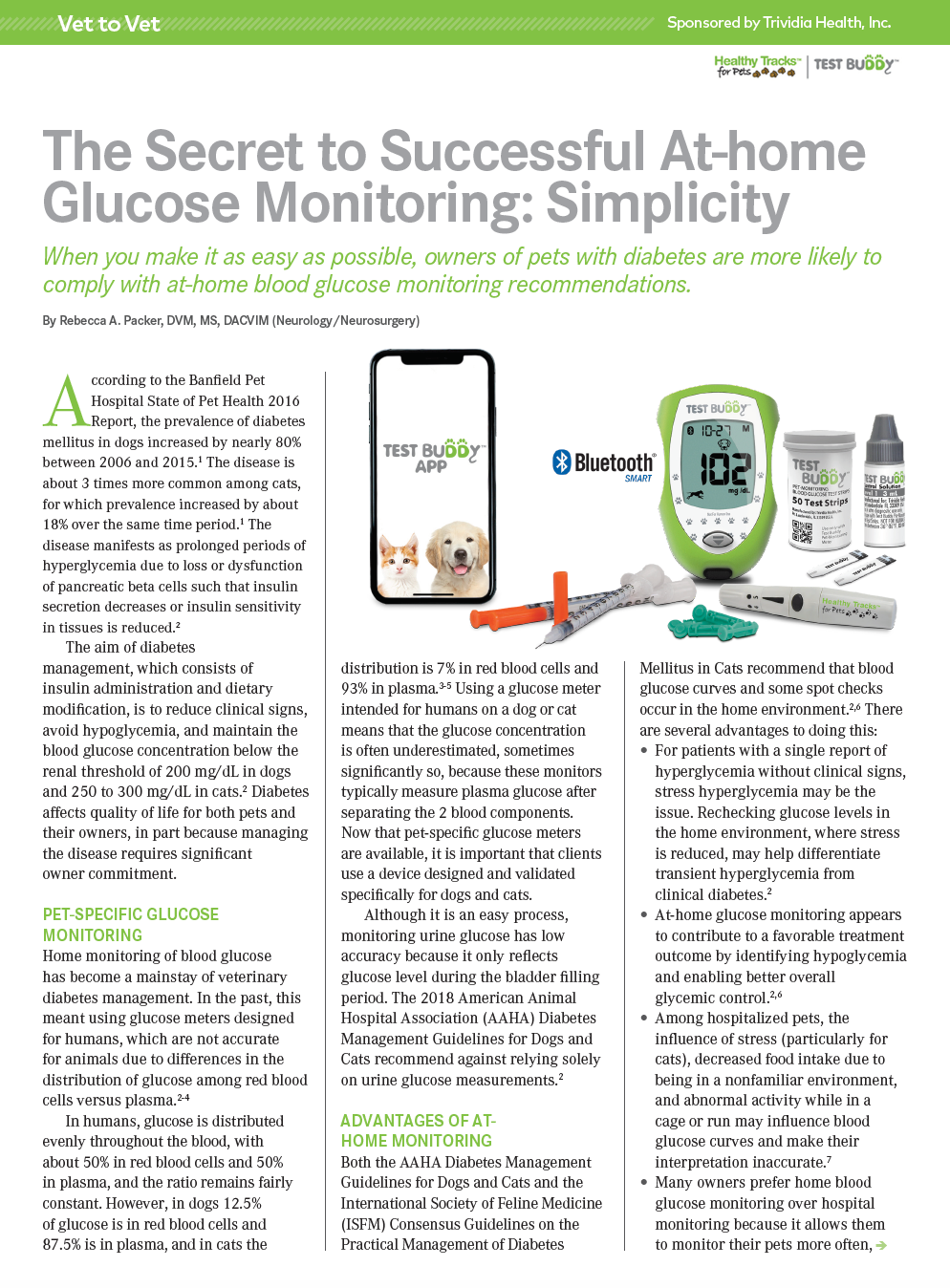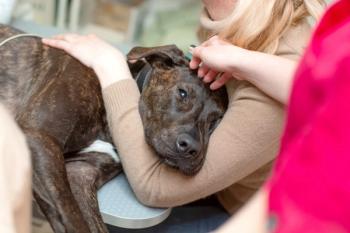- Among hospitalized pets, the influence of stress (particularly for cats), decreased food intake due to being in a nonfamiliar environment, and abnormal activity while in a cage or run may influence blood glucose curves and make their interpretation inaccurate.7
- Many owners prefer home blood glucose monitoring over hospital monitoring because it allows them to monitor their pet more often, identify changes in blood glucose concentrations earlier, and correlate whether blood glucose changes are related to changes in their pet’s well-being. At-home monitoring also reduces stress for the pet and costs a bit less for the owner.7
- Home monitoring may help identify spontaneous remission of diabetes.6
Some veterinarians have concerns about compliance with home monitoring and worry that their patients with diabetes will fail to return for recheck examinations and appointments. The reality, however, is that most clients do return as recommended and, with very rare exceptions, continue to wait for professional guidance before making adjustments to their pet’s insulin dosing based on the data they collect at home.7
Timing of glucose curves
According to AAHA and ISFM recommendations, performing blood glucose curves often serves 2 important purposes.2,6 First, they can reveal subclinical hypoglycemia, so that adjustments can be made to the insulin dose before clinical signs or critical situations develop. Second, in patients whose diabetes is not well controlled, it can be challenging to determine whether the reason is too high or too low of an insulin dose.2 Detailed blood glucose curves provide information that can be used in making treatment decisions and dose adjustments.2,6
The timing of glucose curves varies slightly among patients depending on the type of insulin and dosing regimen used. Detailed recommendations are described in the AAHA guidelines.2
In general, when acquiring a blood glucose curve, glucose is measured every 2 to 4 hours for 12 to 24 hours. If the blood glucose concentration is below 150 mg/dL, measurements should be taken hourly.2
AAHA and ISFM offer similar but slightly different guidelines for when to perform blood glucose curves, but both recommend that they be performed at home. According to the AAHA guidelines, blood glucose curves should be done after the first dose of a new type of insulin is administered, 7 to 14 days after a dose adjustment, if clinical signs recur in a patient whose disease was controlled previously, any time hypoglycemia is suspected, and then regularly at 3-month intervals.2
For feline patients, ISFM guidelines recommend performing blood glucose curves weekly following diagnosis until the patient’s glycemic control is stable, and then every 3 to 4 weeks. They further recommend checking isolated blood glucose measurements any time the owner is concerned about the cat’s well-being.6 If intensive management is necessary, several daily blood glucose measurements may be taken. If less frequent monitoring is recommended, blood glucose curves may be performed every 2 to 6 weeks, with single measurements obtained whenever there are concerns, and before insulin dosing when recommended.6
Advantages of the Test Buddy™ Pet-Monitoring Blood Glucose System
- Fast: Test results ready in about 10 seconds
- Easy to use: Simple button operation allows the user to easily select the animal species and begin the simple 2-step testing process
- Convenient: Clients can monitor their pet’s blood glucose levels from the comfort of home
Compliance made easy
Due to the frequent need for sampling, having an easy-to-use system for home blood glucose monitoring is crucial to maintaining owner compliance and ensuring accurate sampling.
This includes not only the meter and test strips but also ancillary items such as lancets and a lancing device. The associated software app must be intuitive, easy to set up and connect to the meter, and provide ample storage for sample values so that data are useful to veterinarians when downloaded. If owners struggle with any of these components, compliance declines and data quality suffers.
Home glucose monitoring using the Test Buddy™ Pet-Monitoring Blood Glucose System and Healthy Tracks for Pets™ ancillary products can be instrumental in the comprehensive management of your diabetic patients. The portfolio features high-quality,5 affordable products designed and calibrated specifically for dogs and cats with diabetes.
Developed with specific chemistry and a unique algorithm, the Test Buddy™ Pet-Monitoring Blood Glucose Meter allows clients to track and monitor their pet’s blood glucose levels at home with confidence. Unlike some other pet-specific glucose monitors on the market, Test Buddy™ offers simple pet selection with no coding necessary, stores up to 1000 results with corresponding dates and test times, and includes 4 event and meal tags to combine the pet’s activities (e.g., exercise, mealtimes) with their results. Bluetooth compatibility allows clients to sync the data smoothly with the Test Buddy™ App on a mobile device and send accurate results to their veterinarian quickly and easily. Ancillary products are also available to make the job easier, including Healthy Tracks for Pets™ Syringes (U-40 and U-100), Lancing Device, and Sterile Lancets. For more information, visit www.testbuddymeter.com.
References
1. State of pet health 2016 report. Banfield Pet Health. 2016. Accessed Sept 24, 2020. https://www.banfield.com/banfield/media/pdf/downloads/soph/banfield-state-of-pet-health-report-2016.pdf
2. Behrend E, Holford A, Lathan P, Rucinsky R, Schulman R. 2018 AAHA Diabetes Management Guidelines for Dogs and Cats. J Am Anim Hosp Assoc. 2018;54(1):1-21. doi:10.5326/JAAHA-MS-6822
3. Coldman MF, Good W. The distribution of sodium, potassium and glucose in the blood of some mammals. Comp Biochem Physiol. 1967; 21(1):201-206. doi:10.1016/0010-406x(67)90129-6
4. Surman S, Fleeman L. Continuous glucose monitoring in small animals. Vet Clin North Am Small Anim Pract. 43(2):381-406. doi:10.1016/j.cvsm.2013.01.002
5. Data on file. Trividia Health, Inc.
6. Sparkes AH, Cannon M, Church D, et al. ISFM consensus guidelines on the practical management of diabetes mellitus in cats. J Feline Med Surg. 2015; 17(3):235-250. doi:10.1177/1098612X15571880
7. Kley S, Casella M, Reusch CE. Evaluation of long-term home monitoring of blood glucose concentrations in cats with diabetes mellitus: 26 cases (1999-2002). J Am Vet Med Assoc. 2004;225(2)261-266. doi:10.2460/javma.2004.225.261






